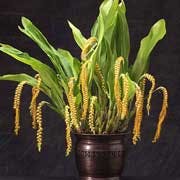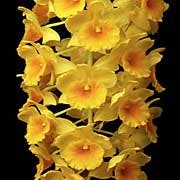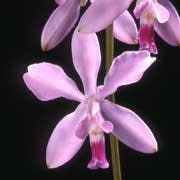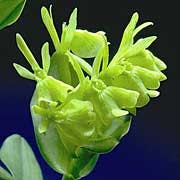D
dactyloides (dak-til-OY-deez) Resembling fingers; fingerlike.
Dactylostalix (dak-til-oh-STAY-liks) This monotypic terrestrial genus is endemic to Japan. H.G. Reichenbach described the genus in 1878, coining the name from two Greek words for "finger" and "stake" to describe the fingerlike crest on the lip.
damp or damp down (damp, damp daun) To spray or sprinkle the walks, benches, etc. of a greenhouse to cool it or to increase humidity without directly watering the pots or plants.
damping off (damp-ing awf) The collapse of seedlings, usually caused by infestations of the fungi Botrytis vulgaris or Phythium debaryanum.
Darwin, Charles (1809—1882) British naturalist whose theory of evolution by natural selection was based in part on the results of his studies of orchids. His subsequent opus, On the Various Contrivances by Which British Orchids are Fertilized by Insects, laid the foundation for studying pollination biology in orchids.
Day, John (1824—1888) Influential orchid hobbyist of his time, he became famous for his excellent orchid drawings and paintings, with nearly 3,000 illustrations of cultivated orchids filling 17 books.
debilis, -e (DEB-ill-is) Weak; frail; not robust.
deciduous (di-SIJ-oo-uhs) The shedding of leaves or other organs at maturity or at the end of the growing season; not permanent, transitory.
decipiens (de-SIP-iens) Deceptive; not obvious.
declinate (DEK-luh-neyt) Bent or curved downward or forward.
decorus, -a, -um (dek-OR-us) Decorative; becoming; comely.
decumbens (dee-KUM-benz) Reclining but with the growing end upright; decumbent.
decurrens (dee-KUR-enz) Extending down the stem or ovary below the point of insertion; decurrent.
decurved (dee-KURVD) Curved downward.
decussate (dee-KUSS-ayt) Opposite leaves in four rows up and down the stem, alternating in pairs at right angles.
deflexus, -a, -um (dee-FLEX-us) Bent abruptly downward; deflexed.
defoliation (dee-FOL-ee-ay-shun) The casting off or falling of the leaves.
dehiscens (dee-HISS-enz) Dehiscent; the splitting into definite parts by valves, slits or pores, as the capsule or fruit of orchids.
delicatus, -a, -um (del-i-KAY-tus) Tender; delicate.
deltoideus, -a, -um (del-TOY-dee-us) Broadly triangular; shaped like the Greek letter delta (D); deltoid.
dendricolus, -a, -um (den-DRI-koh-lus) Living on trees; epiphytic.
Dendrobium (den-DROH-bee-um) A genus of 900 species of tropical Asian and Pacific epiphytic, lithophytic and terrestrial orchids, variable in plant structure, established by Swartz in 1799, the name derived from the Greek for tree and life, in reference to the epiphytic habit of the plants.
Dendrochilum: Dendrochilum magnum is an example of the genus, although it is currently classified as Coelogyne magna.

Dendrochilum (den-droh-KYE-lum) A genus of 100 species of Asiatic orchids related to Coelogyne. Noted for its long arching scapes with many flowers, it was described by Blume in 1825, the name possibly referring to the epiphytic habit of the plants.
dendrogram (DEN-droh-gram) A pictorial representation of presumed phylogenetic history, a family tree.
dendroideus, -a, -um (den-DROY-dee-us) Treelike; tree-shaped; dendroid.
Dendrophylax (den-droh-FYE-laks) A genus of six species of leafless Antillean monopodial orchids related to Angraecum, described in 1861 by Reichenbach, the name alluding to the manner in which the roots surround the tree branch on which the plant grows.
Densiflorum: Dendrobium densiflorum is a densely-flowered species.

densiflorus, -a, -um (den-si-FLOR-us) Having the flowers densely clustered; densely flowered.
densifolius, -a, -um (den-si-FOH-li-us) Densely leaved.
densus, -a, -um (DEN-sus) Thick; compact; dense.
dentatus, -a, -um (den-TAY-tus) Toothed; furnished with teeth; dentate.
denticulatus, -a, -um (den-tik-yew-LAY-tus) Minutely toothed; slightly dentate; denticulate.
Deoxyribonucleic Acid (DNA) (dee-ox-ee-RYE-bow-new-clay-ick As-id) The primary genetic material of all cells contained within the chromosomes.
depauperatus, -a, -um (dee-paw-per-AY-tus) Imperfectly developed; lacking; depauperate
depressus, -a, -um (dee-PRESS-us) Flattened; pressed down; depressed.
dependens (dee-PEND-enz) Hanging down; dependent.
descending (dee-SEND-ing) In a gradually downward direction.
desert cooler (DEZ-ert kool-er) The name for a commonly used self-contained evaporative cooler.
determinate (dee-TUR-muh-neyt) Condition of inflorescence when the terminal flower opens first and so terminates further elongation of the floral axis.
Dextrorse (DEK-strohs) Turning toward the right.
Di or Dis (DYE or Dihs) The Greek prefix for two.
Diacrium (see Caularthron)
diagnosis (dahy-uhg-NO-sis) The comparative statement, usually in Latin, that typically appears with the description of a new taxon.
Dialaelia (die-ah-LEE-lee-ah; die-ah-LIE-lee-ah) A hybrid genus between Diacrium and Laelia created in 1905. These hybrids are now called Caulaelia (Caularthron x Laelia).
diandrous (dye-an-druhs) Having two anthers.
Diaphananthe (dye-ah-fah-AN-thee) A tropical African epiphytic genus of around 45 species. Schlechter described the genus in 1914, deriving the name from the Greek words for "transparent" and "flower" to describe the almost-translucent flowers.
diaphanus, -a, -um (dye-AFF-an-us) Transparent or translucent; diaphanous.
dicarpellous (dye-KAR-pel-lus) Composed of two carpels.
Dichaea (dye-KEE-a) A medium-sized genus of pseudomonopodial epiphytic orchids from tropical America, characterized by two ranks of short, flattened, closely set leaves. It was described by Lindley in 1833, the name derived from the Greek meaning two-fold in reference to the two ranks of leaves.
dichogamy (dye-KOG-ah-me) Having stamens and pistils maturing at different times, thus avoiding self-pollination.
dichotomus, -a, -um (dye-KOT-oh-mus) Forked in pairs; repeatedly dividing into two branches; dichotomous, as in a dichotomous key.
Dichroma: Encyclia dichroma flowers are two-colored.

dichromus, -a, -um (dye-KROH-mus) Two-colored; of two distinct colors.
diclinous (di-KLYN-us) Unisexual, having the androecium and gynoecium in separate flowers.
dicotyledonous (dye-kot-i-LEE-don-us) Having two cotyledons.
didymus, -a, -um (DID-i-mus) Twin; found in pairs; somewhat two-parted.
differentiation (dif-fer-en-she-ay-shun) The physiological and morphological changes that occur in a cell, tissue or organ during development to a different state.
Difforme: Epidendrum difforme flowers have an unusual shape for the genus.

difformis, -e (di-FORM-is) Of unusual form in comparison with the normal for the genus.
diffusus, -a, -um (dif-FEW-sus) Loosely branching or spreading; of open growth; diffuse.
digitatus, -a, -um (dig-i-TAY-tus) Shaped like an open hand; finger-like; digitate.
dilatatus, -a, -um (dye-la-TAY-tus) Spread out; dilated.
Dillon, Gordon (1912—1982) Former editor of American Orchid Society Bulletin (from 1943—1968, 1970—1973) and a former Executive Director of the Society (Ex. Sec. 1950—1977, Ex. Dir. 1976).
Dilochia (dye-LOH-kee-ah) A small genus of epiphytic orchids from Southeast Asia, related to Arundina; it was described by Lindley in 1830, the name alluding to the two rows of bracts.
dimidiate (dye-MEE-dee-ayt) Said of an object having one half missing, halved.
dimorphus, -a, -um (dye-MOR-fuss) Having two dissimilar forms of leaf, flower or fruit on the same plant.
Dimorphorchis (dye-MORF-ore-kiss) Borneo is home to the three epiphytic species in this genus. Rolfe described the genus in 1919 and coined the name from the Greek words meaning "two," "shape" and "orchid," to denote the two distinct types of flowers borne on the same inflorescence.
dioecious (dye-EE-shus) Unisexual, with the male and female flowers on separate plants.
Diothonea (dye-OH-thon-ee-a) A small epiphytic genus of approximately six species found in tropical South America. First described in 1834 by Lindley, who used the Greek words "two" and "sail" to describe the unique sail-like structure between the column and lip.
diphyllus, -a, -um (dye-FILL-us) Having two leaves; diphyllous.
Diplocaulobium (dih-plo-caw-LOBE-ee-um) A primarily Australasian genus of about 100 species, formerly included in a broadly defined Dendrobium, known for its ephemeral flowers.
diploid (DIP-loyd) Having a complement of two similar sets of chromosomes (2n)
Diploprora (dih-plo-PROR-a) The four epiphytic species in this genus range from India and Sri Lanka east to Taiwan. Hooker identified the genus in 1890 and derived the name from the Greek words meaning "two" and "prow" to describe the bifurcate lip.
Dipodium (dye-POH-dee-um) A small genus of orchids of diverse vegetative character from China, Southeast Asia and on through New Caledonia, it is related to Cymbidium and was founded by Robert Brown in 1810, the name derived from the Greek meaning "two little feet" in reference to the two stipes of the pollinia.
dipterus, -a, -um (DIP-ter-us) Two-winged; dipterous.
Disa (DYE-sa or DEE-sa) A large genus of terrestrial orchids found chiefly in tropical and southern Africa, established by Bergius in 1767, the derivation of the name being obscure, but the genus is noted for the beauty and unusual structure of its flowers.
disc (disk) In orchids, the face or upper surface of the middle portion of the lip.
discolor (DIS-kol-or) Of two different and usually distinct colors.
discrete (dis-KREET) Separate, not coalescent.
Disperis (DIS-per-is) This genus of about 80 terrestrial species ranges from South and tropical Africa east to New Guinea. Olaf Swartz described the genus in 1800, coining the generic name from the Greek words meaning "two" and "wallet" to denote the pouchlike lateral sepals found in some species.
dissectus, -a, -um (dis-SEK-tus) Divided into deep lobes or segments; deeply cut; dissected.
distal (DIS-tul) Remote from the place of attachment.
Distichus: Isochilus linearis has distichus leaves.

distichus, -a, -um (DIS-tik-us) Arranged in two rows or ranks; distichous.
Diuris (dye-YEWR-is) A medium-sized genus of predominantly Australian terrestrial orchids, described by J.E. Smith in 1798, popularly called "double tails," the name referring to the two tail-like lateral sepals.
diurnus, -a, -um (dye-URN-us) Of the daytime; with flowers open during the day; diurnal.
divaricatus, -a, -um (dye-vayr-i-KAY-tus) Separated by a wide angle; widely spreading; divaricate.
divergens (dy-VERJ-enz) Spreading out widely; divergent.
divisus, -a, -um (di-VYE-sus) Separated to the base; divided.
division (di-vihz-uhn) The technique of propagating plants by cutting or breaking apart the pseudobulbs or stems at the rhizome; a single propagation derived in that manner.
dixanthus, -a, -um (dye-ZAN-thus) Having flowers of two shades of yellow.
dm (decimeter) A measure of length equal to 3.937 inches or 10 centimeters.
dolabriformis, -e (doh-lab-ri-FORM-is) Hatchet-shaped.
dolosus, -a, -um (doh-LOH-sus) Deceitful; appearing like some other plant.
dominant (DOM-uh-nuhnt) Said of an allele (any of several forms of a gene responsible for hereditary variation....see allele) that expresses itself relative to its sister allele.
domingensis, -e (doh-min-GEN-sis) Native of Santo Domingo (now the Dominican Republic)
Domingoa (doh-ming-GOH-ah) A small genus of epiphytic orchids from the West Indies, related to Laelia, established by Schlechter in 1913. The name is derived from Santo Domingo, former name of the Dominican Republic.
Dominy, John (1816—1891) British nurseryman and orchid grower for the firm of James Veitch & Sons, he was the first to breed and flower an artificial orchid hybrid, Calanthe Dominyi, in 1856.
Doritaenopsis (doh-rye-tee-NOP-sis) A hybrid genus between Doritis and Phalaenopsis created in 1923.
Doritis (doh-RYE-tis) A genus of three terrestrial vandaceous orchids, closely related to Phalaenopsis, sparsely distributed throughout Southeast Asia and Sumatra. It was described by Lindley in 1833, the name referring to Doritis, one of names for the goddess Aphrodite. Recently transferred to Phalaenopsis by Christenson.
dorsal (DAWR-suhl) Referring to the upper surface of an organ such as a leaf; that surface turned away from the axis; opposite of ventral.
Dossinia (doss-IN-ee-ah) A monotypic genus of terrestrial orchids from Borneo. Called "Jewel Orchids" because of the dazzling beauty of the foliage, it was found by E. Morren in 1848, the name in compliment to the Belgian botanist E.P. Dossin (1777—1852)
double (DUHB-uhl) Said of flowers that have more than the usual number of floral envelopes, particularly of petals.
downy (DOW-nee) Covered with very short and weak soft hairs.
draco (DRAY-ko) Specific name meaning a dragon.
Dracula (DRACK-yule-ah) A large genus of more than 100 phantasmagoric Neotropical species, related to Masdevallia.
Drakaea (DRAYK-ee-a) A genus of four species of terrestrial orchids limited to Western Australia, allied to Caleana and Spiculaea. It was established by Lindley in 1839, honoring the botanical artist Miss S.A. Drake, who drew many of the plates for Bateman's monumental volume, The Orchidaceae of Mexico and Guatemala.
Dresslerella (dress-LER-ell-a) There are eight epiphytic species in this genus that ranges from Nicaragua south to Peru. In 1970, Luer established the genus, a segregate from Pleurothallis, naming it in honor of Robert Dressler, PhD.
Dressleria (dress-LER-ee-ah) In 1975, Dodson established this genus of three epiphytic species that are similar to Catasetum. The genus ranges from Nicaragua to northern South America and was named in honor of Robert Dressler, PhD.
Dryadella (dry-ah-DELL-ah) About 40 species compose this Neotropical genus of miniature caespitose epiphytes previously included in a broadly defined Masdevallia.
dubiosus, -a, -um (doo-bee-OH-sus) Doubtful; not in conformity to the pattern of the genus; dubious.
dulcis, -e (DULL-sis) Sweet.
dumosus, -a, -um (doo-MOH-sus) Low and branching, as a bush; bushy; shrubby.
dunensis, -e (doo-NEN-sis) Of or pertaining to sand dunes.
Dungs, F. (1915—1977) Noted Brazilian orchidologist and coauthor with Pabst of the exhaustive work Orchidaceae Braziliensis.
duplicate (DOO-pli-kit) Double or doubled over, as the two similar sides of a leaf.
Duthie, John Firminger (1845—1922) British botanist responsible for the monumental The Orchids of North-Western Himalaya.
Dyakia (dye-ACK-ee-ah) A monotypic epiphytic monopodial genus from Borneo. Christenson described the genus in 1986, using the Malay name Dyak in honor of the indigenous people of Borneo.








